Millions of adventure-fantasy fans are
convinced that Tarzan of the Apes spent his youth in the jungles of Africa,
growing to manhood there. If they are speaking of the “real” Tarzan, the
immortal fictional creation of Edgar Rice Burroughs, they are correct.
But when it comes to the “reel” Tarzan, there are many different homes.
To date, 17 men have cavorted across the silver screen as Tarzan, dating
back to bare-chested Elmo Lincoln’s debut in 1918.
In the opinion of many Tarzan fans, the greatest
of the reel Tarzans is a Washington State product, who built his muscular
frame in the woods near Tacoma and honed his considerable athletic skills
in Seattle. Herman Brix was born and raised in Tacoma, the fourth of five
children. His father worked in the lumber business, and Herman benefited
from the association with his father’s physically demanding job. “I worked
a lot in the lumbering business as a youngster,” says Brix, recently interviewed
in his Beverly Hills office, where he is in the real estate business. “I
spent most of my summer vacations in the woods, or in the logging camps.
Just plain hard work helped me develop my physique.”
Brix was a natural athlete as well. In high school,
he participated in football, basketball, track and soccer, earning a total
of 16 letters. He and his brother, Egbert, both enrolled at the University
of Washington, and became football standouts. Egbert earned letters in
1924 and ’25, while Herman was a starter for three years – 1925, ’26 and
’27. The 1925 Washington team posted a 10-1-1 record, opening with a 108-0
rout of outmanned Willamette and closing with a 20-19 loss to Alabama in
the Rose Bowl.
But it was in track and field that Herman Brix
really excelled. Quick and skilled as well as powerful, he ran the hurdles,
threw the javelin and heaved the shot.
“In those days, I was called the ‘blond giant,'"he
says with a chuckle. “I was six feet, two inches tall and weighed about
195 pounds. The heaviest I ever got was 201 pounds, but that was pretty
big then, I guess.”
During his Seattle years, Brix matured into the
nation’s best shot-putter. He was undefeated for over five years in his
specialty in all types of competition, and earned a total of seven national
titles, including the NCAA crown in 1927. In 1928, he finished first in
the United States Olympic trials, and wound up with a silver medal at the
Olympic Games in Amsterdam. The former Seattle star broke the Olympic record
on his first effort in Amsterdam, and led the competition until the final
toss of the day. John Kuck, his teammate from Kansas, unleashed a toss
that edged Brix’s by several inches, giving the US the top two spots.
At the games, Brix became friends with two swimmers.
Remarkably, within just six years all three of them were in Hollywood starring
in Tarzan films for three different companies. “Sure, I can remember being
over there with Johnny (Weissmuller) and Buster (Crabbe),” says Brix. “We
hung around a little together on ship and cheered for each other.”
After the Olympics, Brix returned to Seattle prepared
to find a job, but when he was contacted by the Los Angeles Track Club
he moved to California. His life was about to take a dramatic turn.
“I met Douglas Fairbanks at a track meet and he
invited me to train at his personal quarters,” explains Brix. In the 1930s,
Fairbanks and his dazzling wife, Mary Pickford, were the reigning royalty
of Hollywood. Brix continued working hard at the shot put, until the day
he heard about MGM’s tryouts for the lead role in a Tarzan movie. He hustled
over at Fairbanks’ urging and got the role. First, however, there was the
matter of a minor part in a movie entitled “Touchdown.”
Brix showed up for the first day of shooting, and
proceeded to break his arm in a freak accident. The arm was in a cast for
six weeks, knocking him out of both films. MGM, unable to wait for Brix’s
arm to heal, selected a lanky swimmer for the lead in “Tarzan the
Ape Man” and Weissmuller proved an immediate sensation.
Author Burroughs, despite the enormous financial
success of the MGM films, was hugely disappointed by the manner in which
Tarzan was portrayed. He had conceived the apeman as a physical Adonis
with a mind to match, a renaissance man fluent in several languages. MGM
saw Tarzan as a buffoon, upstaged by chimpanzees, Jane and Boy. When another
film company came out with the equally disappointing “Tarzan the Fearless”
in 1933, starring Crabbe, Burroughs was prodded into action. He and several
businessmen formed their own company, determined to depict the apeman as
he was written. An extensive search was organized to find the ideal Tarzan
– and Herman Brix was selected.
In late 1934, a cast and crew of 29 left California
on the appropriately named liner “Seattle” for Guatemala. The ship reached
its destination in the midst of a howling storm, and much of the filming
took place in remote highlands under adverse and primitive conditions.
“The filming was arduous,” recalls Brix, who was instructed to dye his
hair black for the role. “I was in the hospital a number of times with
cuts and abrasions. I weighed about 190 pounds when we got there, and was
down to 171 pounds by the time we finished up.”
In spite of the considerable hardship, Brix was
magnificent in his first starring effort. Moving with the ease of a great
athlete, he appeared comfortable in all of the action sequences. His physique,
with its hard, cordlike muscles, provided a sharp contrast to the more
smoothly muscled bodies of Weissmuller and Crabbe. In one scene, the physique
was shown to particular advantage. Tarzan is tied to a post, left to be
eaten by savage jungle predators. He escapes by simply tensing his muscles
until his bulging sinews actually pull the ropes apart – an easy feat for
today’s special effects wizards, but Brix did it with his own natural strength.
The movie was released first as a feature – New
Adventures of Tarzan – and then as a serial, “Tarzan and the Green Goddess.”
Well received at the time, they have since become highly regarded by Tarzan
purists.*
“Brix’s portrayal was the only time between the
silent and the 1960s that Tarzan was accurately depicted in films,” wrote
Gabe Essoe in is book “Tarzan of the Movies.” “He was mannered, cultured,
soft-spoken, a well-educated English lord who spoke several languages and
didn’t grunt, and because of its fidelity to the books, the film has become
a classic…”
Unfortunately, the movie was marred by an atrocious
soundtrack, actually apologized for in the credits. It was redubbed for
TV, so viewers today get a better audio, but the voice of Tarzan does not
belong to Brix.
Brix was typecast by his Tarzan performance, and
in the next few years was able to land only a few roles in serials, the
bottom of the filmmaking world of the 1930s. One such serial, Republic
Studio’s “Hawk of the Wilderness,” furthered Brix’s typecasting, but
gave audiences another chance to see the magnificent athlete at his physical
best, once again portraying a white hero marooned in the wilderness, and
supreme in his primitive world.
Despite the success of “Hawk of the Wilderness,”
Brix decided to leave the film scene for a few years to study acting. His
return was hastened by the advent of World War II. Adopting the screen
name of Bruce Bennett, he found many roles beginning in the early ‘40s.
He is perhaps best known for his role as the heroic tank commander in “Sahara”
who treks across the desert to get help for his besieged company. As Bennett,
he appeared in nearly 140 more films, in major roles and in films that
have become legends. He was Joan Crawford’s husband in “Mildred Pierce,”
the role that earned her an Academy Award. In “Treasure of the Sierra Madre,”
he was punched by Humphrey Bogart. In “The Last Outpost,” he played opposite
Ronald Reagan, and later served on the board of the Screen Actors Guild
when Reagan was its president.
Today, Brix and his wife of many years, Jeanette,
live in Beverly Hills, not far from his downtown office. They take long
trips in the summer, to such places as Australia, the British Isles and
Santorini, the crater island in the Aegean that many are convinced is ancient
Atlantis.
Although there was a time when Brix was not overly
fond of his days as Tarzan, he finally has come to enjoy the attention
it brings him. He continues to receive mail from around the world, asking
for autographs and photos. Many Tarzan fans now regard him as the best
“reel” Tarzan of ‘em all.
NOTES
*Actually, "New Adventures" was the serial
(1935) and "Green Goddess" was the feature film (1938).
Note: Brix/Bennett passed away Feb. 24, 2007

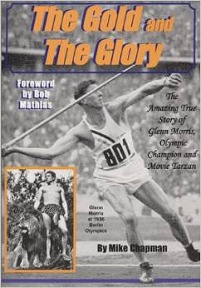 ..
..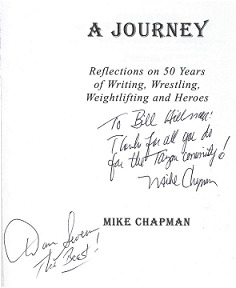
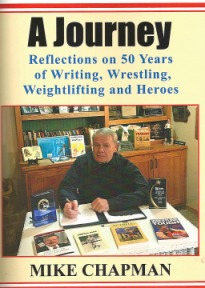

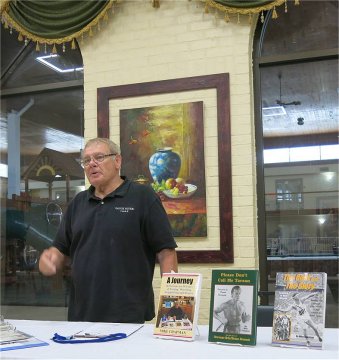
![]()
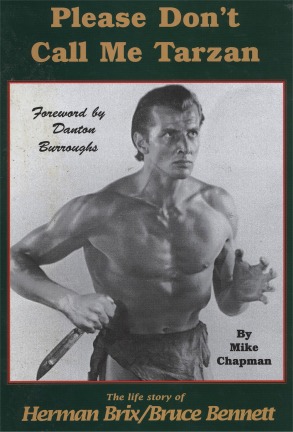
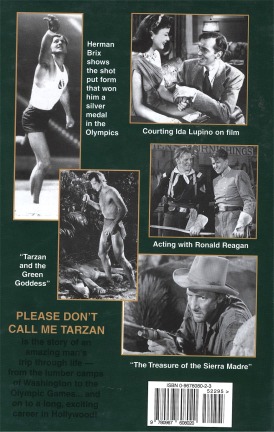

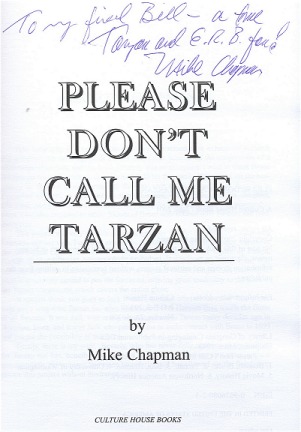
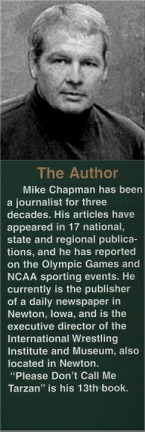
![]()
![]()
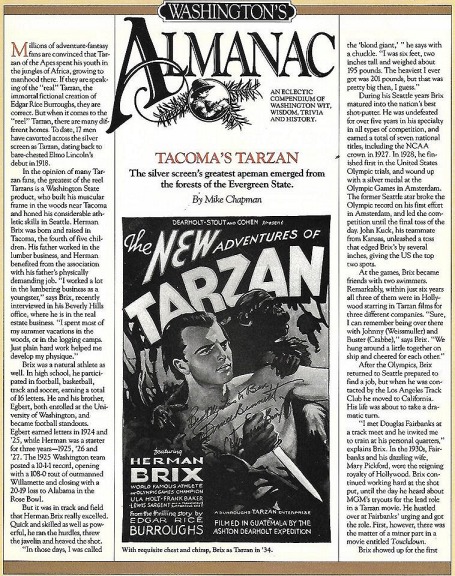
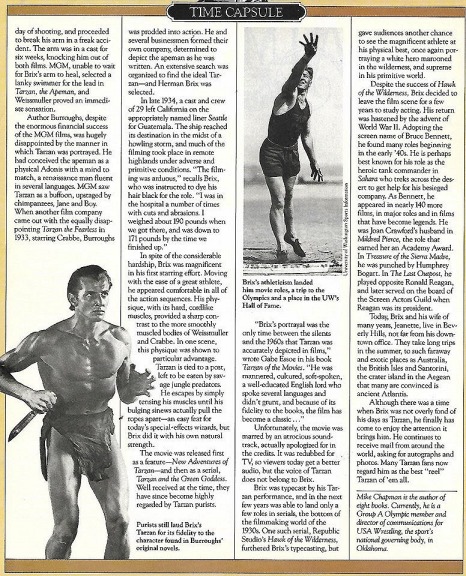
 ..
..

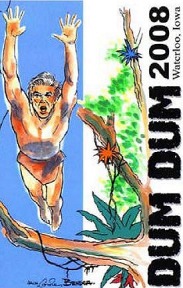
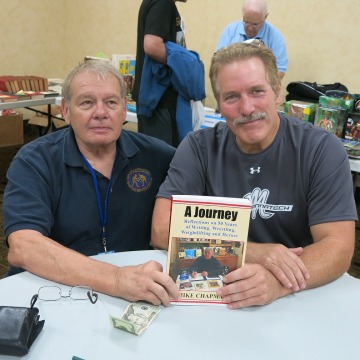 Mike
Chapman of Newton, Iowa has been elected to receive the Order of Merit
from the National Wrestling Hall of Fame and Museum in Stillwater, Okla.
The Order of Merit is presented to an individual who has made significant
contribution to the advancement of wrestling, other than success as an
athlete or coach. The winner is selected by a vote of the Distinguished
Members of the National Wrestling Hall of Fame. Chapman, a professional
journalist with a passion for wrestling, has been a leader within the sport
for decades with a focus on the promotion of the sport. His involvement
has been at many levels, including as a publisher, author, historian, publicist
and speaker. Gifted as a writer and communicator, Chapman has used those
skills to tell the stories of wrestling?s heroes and bring the excitement
and drama of the sport to millions of people worldwide.
Mike
Chapman of Newton, Iowa has been elected to receive the Order of Merit
from the National Wrestling Hall of Fame and Museum in Stillwater, Okla.
The Order of Merit is presented to an individual who has made significant
contribution to the advancement of wrestling, other than success as an
athlete or coach. The winner is selected by a vote of the Distinguished
Members of the National Wrestling Hall of Fame. Chapman, a professional
journalist with a passion for wrestling, has been a leader within the sport
for decades with a focus on the promotion of the sport. His involvement
has been at many levels, including as a publisher, author, historian, publicist
and speaker. Gifted as a writer and communicator, Chapman has used those
skills to tell the stories of wrestling?s heroes and bring the excitement
and drama of the sport to millions of people worldwide.

